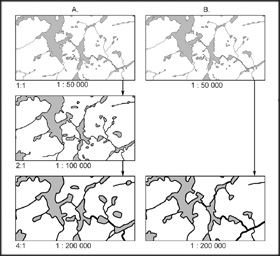|
|
Common Rules for Generalisation
Cartographer’s have the first role in deciding the purpose and the extent of generalisation. The following common rules will help you to organize your map generalisation.
Generalisation can be carried out in two ways:
- The map elements are generalised at the scale of the source map, and then reduced to the desired scale.
- The map elements are reduced to a smaller scale, and then generalised.
Both methods have advantages and disadvantages: If you work at the source scale, you will have a clearer picture of all the details, and this can be very important if the map is complex. For example, the omission process can be handled much easier in this way. If you work at the reduced scale, the generalisation will be more appropriate to the derived map, but the reduction of the source can lead to an incorrect interpretation for the generalisation. Therefore, you have to anticipate the effect of scale reduction when deciding the generalisation method to use.
In a more general way, you should always generalise original data. Or if you cannot on the smallest scale possible data. Indeed, several problems exist with an already generalised basis:
- The decisions, choices and grouping are unknown.
- The displacement carried out, as well as the simplifications are unknown.
- A badly generalised basis becomes worse still in the next generalisation step.
Generalisation and Generalised Basis.
This illustration shows you by a concrete example, why it is necessary to use original data and not an already generalised
basis. The outcome of the right method is bad, and can lead the map reader to incorrect conclusions, because it is based on
an already generalised basis. While the outcome of the left method is, correct.
 Generalisation and Generalised Basis (Schweizerische Gesellschaft für Kartographie 2002)
Generalisation and Generalised Basis (Schweizerische Gesellschaft für Kartographie 2002)